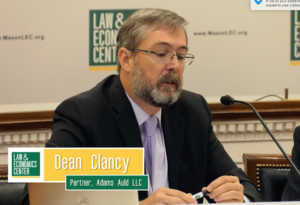An educational briefing for Congress.
I had the honor today of participating in a panel discussion on Capitol Hill with several distinguished experts on the topic of federal medical malpractice reform.
The discussion, sponsored by the Antonin Scalia Law School of George Mason University (GMU), is the latest in a series of lunchtime educational briefings for Members of Congress and senior staff. The briefings focus on judicial and legal issues. Today’s panel:
- Michael C. Stinson
Vice President, Physician Insurers Association of America (PIAA) - David Hyman
Professor of Law, Georgetown University Law Center - Taylor Lincoln
Director of Research, Congress Watch, Public Citizen - Dean Clancy
Partner, Adams Auld LLC - Moderator: John J. Kornacki
Director of Education, Law & Economics Center, Antonin Scalia Law School, George Mason University
Mr. Stinson opened by arguing in defense of federal tort reform legislation in the area of medical malpractice.
Professor Hyman presented social science research evidence on what we know about ‘med mal’ reforms and their efficacy. (I thought his presentation tended to weaken the case for such popular ideas as capping damage awards.)
Mr. Lincoln made a policy case against tort reforms, in favor of traditional tort rules and procedures.
I took a middle position, arguing that, while commonsense medical tort reforms are needed, they should take place at the state rather than the national level, because Congress has no power to enact such reforms. I explained the original meaning of the U.S. Constitution on this issue. The Founders considered the trial by jury a bulwark of liberty in both civil and criminal cases. And indeed, preserving the right to “trial by jury of the local vicinage” (i.e., in one’s own local community, under local rules) was one of the chief causes and loudest rallying cries of the American Revolution.
My comments begin around the 27:26 mark and end around the 39:00 mark.

